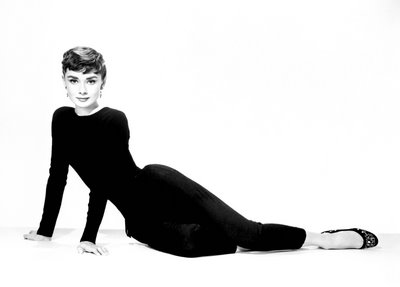Audrey

She was slender, sleek -- a minimalist objet d'art in a gamine haircut and black leotard or black shift dress, composed of some of the same graceful geometries inhabiting the elegant Scandinavian modern designs which were reaching popularity around the time she emerged. She was the visual cousin of Eero Saarinen's tulip chair.
Audrey Hepburn, who was born on this day in 1929 near Brussels, wasn't Scandinavian, though. Nor was she, to paraphrase Billy Wilder's assessment of her distinctive qualities vis-à-vis the rest of Hollywood's emerging casting pool, a "drive-in waitress" who became a "movie star." She was the daughter of a wealthy English banker and a Dutch baroness, and she attended private school in England before moving to Arnhem, Holland with her mother just before the Nazi invasion.
Both she and Anne Frank, whom she did not know but who had hid in an attic nearby in Amsterdam, suffered from malnutrition and depression during the Occupation; but as a privileged child Hepburn could still study ballet -- a source of guilt which no doubt fed her tireless energies on behalf of the UN Children's Relief Fund later in life, and a connection which Hepburn sublimated as the narrator for the premiere of Michael Tilson Thomas' symphonic work, From the Diary of Anne Frank (1990).
After World War II, Hepburn went to England on a ballet scholarship, grew too tall for professional training, and drifted into modeling, acting classes and bit parts in British films before meeting Colette on the French Riviera, who demanded that Hepburn play the lead in the upcoming Broadway adaptation of her play Gigi (1952). Although Broadway critics could be notorious for savaging debut performances, Hepburn's earnest, child-like performance charmed them.
By the end of the next year, she had won an Oscar for her film debut, Roman Holiday (1953, directed by William Wyler), in which she played a princess who wanted to experience Rome as an average carefree young woman would. A mixture of innocence and girlish radiance, haute couture (her partnership with fashion designer Hubert de Givenchy "gave Givenchy a look" according to Ralph Lauren) and elements of gravity and isolation would inhabit most of her finest performances, both in comic and dramatic genres: Sabrina (1954, directed by Wilder); War and Peace (1956, as "Natasha"); Funny Face (1957, with Fred Astaire); Green Mansions (1959) and Breakfast at Tiffany's (1961, as "Holly Golightly").
She was unfairly maligned for her performance in My Fair Lady (1964, with songs lip-synched by Marni Nixon, although the archival soundtrack reveals Hepburn to have been a capable singer with a limited range), but received another Oscar nomination for the suspense thriller Wait Until Dark (1967) before going into semi-retirement. She emerged only fleetingly in films thereafter, turning down numerous offers and spending most of her public time working with UNICEF as special ambassador. She died of colon cancer in Tolochenaz, Switzerland on January 20, 1993.
Labels: Classic Cinema





0 Comments:
Post a Comment
Subscribe to Post Comments [Atom]
<< Home